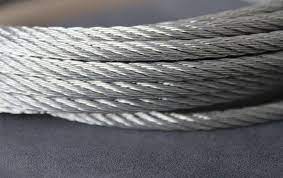Stainless wire, a versatile and indispensable material, has become a cornerstone in various industrial applications due to its exceptional properties. Comprising mainly iron, chromium, and often nickel and other elements, stainless wire rope is renowned for its corrosion resistance, strength, and durability. These attributes make it suitable for a wide range of uses, from construction and manufacturing to medical and household applications.
Composition and Properties
Stainless wire is an alloy of iron with a minimum of 10.5% chromium, which imparts its characteristic corrosion resistance. The chromium forms a passive layer of chromium oxide on the surface, preventing further oxidation and corrosion. This self-healing property ensures that even if the wire is scratched or damaged, the protective layer quickly reforms, maintaining its resistance to rust and tarnish.
Depending on the specific application, stainless wire can also contain other elements such as nickel, molybdenum, and nitrogen. Nickel enhances the alloy’s overall corrosion resistance and ductility, while molybdenum improves resistance to pitting and crevice corrosion in chloride environments. Nitrogen increases the strength of the alloy without compromising its ductility.
Types of Stainless Wire
Stainless wire is available in various grades, each tailored to specific applications:
- Austenitic Stainless Wire: This type, typically containing high levels of nickel and chromium, offers excellent corrosion resistance and formability. Grades such as 304 and 316 are common, with 316 providing superior resistance to chlorides and acidic environments. Austenitic stainless wire is non-magnetic and retains its strength at high temperatures, making it suitable for a wide range of industrial and household applications.
- Ferritic Stainless Wire: Containing higher chromium and lower carbon content, ferritic stainless wire is known for its good corrosion resistance and magnetic properties. It is less ductile than austenitic stainless wire but offers excellent resistance to stress corrosion cracking. Grades like 430 and 446 are often used in automotive applications, kitchen utensils, and architectural elements.
- Martensitic Stainless Wire: This type is characterized by its high carbon content, which allows it to be hardened and tempered through heat treatment. Martensitic stainless wire, such as grades 410 and 420, is known for its high strength and hardness, making it ideal for cutlery, surgical instruments, and mechanical components.
- Duplex Stainless Wire: Combining the properties of austenitic and ferritic stainless steels, duplex stainless wire offers superior strength and resistance to stress corrosion cracking. It is used in demanding applications such as oil and gas exploration, chemical processing, and marine environments.
Applications of Stainless Wire
The unique properties of stainless wire make it suitable for a broad spectrum of applications:
- Construction: Stainless wire is used in structural components, reinforcement, and architectural features. Its strength and corrosion resistance ensure longevity and minimal maintenance.
- Manufacturing: In the manufacturing sector, stainless wire is used to produce springs, fasteners, and wire mesh. Its durability and reliability are crucial in maintaining the integrity of various products.
- Medical: The biocompatibility and ease of sterilization make stainless wire ideal for medical devices and surgical instruments. It is also used in orthodontic appliances and implants.
- Automotive: In the automotive industry, stainless wire is used in exhaust systems, fuel lines, and various other components that require resistance to high temperatures and corrosion.
- Household: Stainless wire is found in a wide range of household items, from kitchen utensils and appliances to cleaning tools and decorative elements.
Advancements and Future Trends
As technology advances, the development of new stainless steel alloys and manufacturing techniques continues to expand the applications of stainless wire. Innovations in metallurgy are leading to the creation of wires with enhanced properties, such as increased strength, better corrosion resistance, and improved workability.
The growing demand for sustainable and environmentally friendly materials is also driving research into more efficient production processes and recycling methods for stainless wire. As industries increasingly prioritize sustainability, stainless wire’s recyclability and long lifespan make it an attractive choice for reducing environmental impact.
Conclusion
Stainless wire’s remarkable properties and versatility make it an indispensable material in modern industry. Its wide range of applications, from construction and manufacturing to medical and household uses, underscores its importance. As technological advancements continue to enhance its properties and sustainability, stainless wire will undoubtedly remain a vital component in various fields, contributing to innovation and progress in countless ways.


